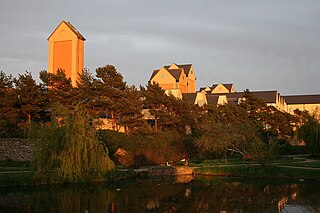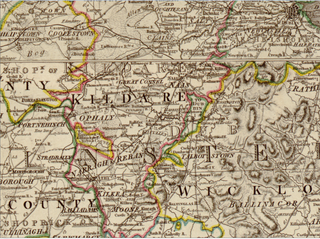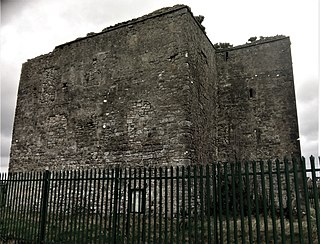
Richard Southwell Bourke, 6th Earl of Mayo, styled Lord Naas from 1842 to 1867 and Lord Mayo in India, was a British statesman and prominent member of the British Conservative Party who served as Chief Secretary for Ireland and Viceroy of India (1869–72).

Earl of the County of Mayo, usually known simply as Earl of Mayo, is a title in the Peerage of Ireland created, in 1785, for John Bourke, 1st Viscount Mayo. For many years he served as "First Commissioner of Revenue" in Ireland. He had already been created Baron Naas, of Naas in the county of Kildare, in 1776, and Viscount Mayo, of Moneycrower in the county of Mayo, in 1781, also in the Peerage of Ireland.

Naas is the county town of County Kildare in Ireland. In 2022, it had a population of 26,180, making it the largest town in County Kildare and the fourteenth-largest urban center in Ireland.

The House of Burgh or Burke was an ancient Anglo-Norman and later Hiberno-Norman aristocratic dynasty which held the earldoms of Kent, Ulster, Clanricarde, and Mayo at various times, provided queens consort of Scotland and Thomond and kings of Britain, and played a prominent role in the Norman invasion of Ireland.
Kill is a village and parish in County Kildare, Ireland near the county's border with Dublin beside the N7. Its population was recorded as 3,818 people in the 2022 census.
The Battle of Knockdoe took place on 19 August 1504 at Knockdoe, in the Parish of Lackagh, County Galway, between two Anglo-Irish lords—Gerald FitzGerald, Earl of Kildare, the Lord Deputy of Ireland, and Ulick Fionn Burke, 6th Clanricarde (d.1509)—along with their respective Irish allies. The cause was a dispute between Maelsechlainn mac Tadhg Ó Cellaigh (O'Kelly), King of Ui Maine – Mod. Irish Uí Mháine) and Clanricarde. The major contemporary sources for this battle are the Gaelic Irish annals and a sixteenth-century manuscript written in the Pale known as "the Book of Howth".

Viscount Mayo is a title that has been created twice in the Peerage of Ireland, both times for members of the Bourke family. The first creation came in 1627 in favour of Tiobóid na Long Bourke, also known as Theobald Bourke. He was the son of Sir Richard Bourke, 18th lord of Mac William Iochtar, and Gráinne O'Malley. Miles, the 2nd Viscount, was created a baronet in the Baronetage of Nova Scotia in c. 1638.
Captain Hubert Henry de Burgh was an Irish cricketer and Officer in the Royal Navy. A right-handed batsman, he played just once for the Ireland national cricket team, a first-class match against Oxford University in June 1926.
Dermot Robert Wyndham Bourke, 7th Earl of Mayo KP PC (Ire) was an Anglo-Irish peer, styled Lord Naas from 1867 to 1872, who served as an Irish representative peer in the British House of Lords (1890–1921) and member of the Senate of Southern Ireland (1921–1922) and Seanad Éireann (1922–1927).
Edmond Albanach de Burgh, 1st Mac William Íochtar was an Irish chieftain and noble who established himself as the most powerful lord in Connacht west of the Shannon.

Joseph Deane Bourke, 3rd Earl of Mayo was an Irish peer and cleric who held several high offices in the Church of Ireland including Bishop of Ferns and Leighlin (1772–82) and Archbishop of Tuam (1782–94).

The High Sheriff of Kildare was the British Crown's judicial representative in County Kildare, Ireland from the 16th century until 1922, when the office was abolished in the new Free State and replaced by the office of Kildare County Sheriff. The High Sheriff had judicial, electoral, ceremonial and administrative functions and executed High Court Writs. In 1908, an Order in Council made the Lord Lieutenant the Sovereign's prime representative in a county and reduced the High Sheriff's precedence. However, the sheriff retained his responsibilities for the preservation of law and order in the county. The usual procedure for appointing the sheriff from 1660 onwards was that three persons were nominated at the beginning of each year from the county and the Lord Lieutenant then appointed his choice as High Sheriff for the remainder of the year. Often the other nominees were appointed as under-sheriffs. Sometimes a sheriff did not serve his full term due to death or another event, and another sheriff was then appointed for the remainder of the year. The dates given in this article are the dates of appointment.

St Mary Magdalen Roman Catholic Church, Mortlake, is a Roman Catholic church in North Worple Way, Mortlake, in the London Borough of Richmond upon Thames. The church is dedicated to Jesus' companion Mary Magdalene. It is located just south of Mortlake High Street and the Anglican St Mary the Virgin Church. St Mary Magdalen's Catholic Primary School is just north of the churchyard.

Honora Burke became Honora FitzJames, Duchess of Berwick on Tweed, married Patrick Sarsfield and went into French exile where he followed her soon afterwards. After his death at the Battle of Landen, she married James FitzJames, 1st Duke of Berwick, an illegitimate son of James II. She may have introduced the country dance to the French court.
John Bourke, 1st Earl of Mayo, styled Lord Naas from 1775 to 1781 and Viscount Mayo from 1781 to 1785, was an Irish politician and peer who was MP for Naas and Old Leighlin (1760–68) and was created Earl of Mayo (1785).

Saint David's Castle is a 13th-century Norman castle located in Naas, Ireland.

The Priory Church of Saint Peter and Saint Paul, Athenry, also called Athenry Priory, is a medieval Dominican priory and National Monument located in Athenry, Ireland.

St David's Church, Naas is a Church of Ireland church in Naas, Ireland.

Woodstock Castle is a 13th-century stone castle located in Athy, Ireland.

White's Castle is a 16th-century tower house in Athy, County Kildare, Ireland. Built on the site of an earlier 15th-century castle, White's Castle was built to guard the main river crossing in Athy and was extended over successive centuries.




















